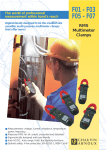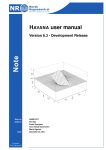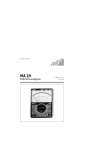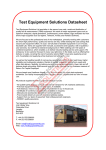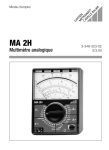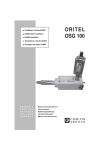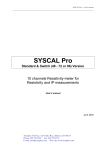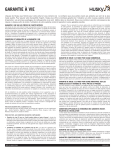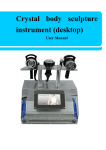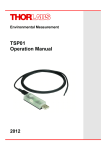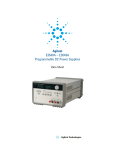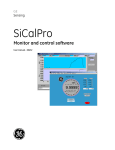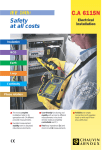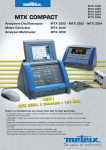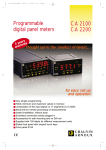Download Maquette Fr
Transcript
Specify in the following sequence: ORITEL RO 600-4, function, language, option and mains lead User-friendly, quick and accurate ■ Models from 1 to 2700 MHz ORITEL RO 600-4 X XX XXXX ORITEL RO 600 • Functions SWR + Insertion loss (IL) . . . . . . . . 1 SWR + IL + Fault location. . . . . . . 2 • Language for messages and user's manual French . . . . . . . . . . . . . . . . English . . . . . . . . . . . . . . . . . . German . . . . . . . . . . . . . . . . . Italian . . . . . . . . . . . . . . . . . . . Spanish . . . . . . . . . . . . . . . . . . . . . . . . . . . . . . . . . . . . . . . . . . . . . . . . . . . . . . . . . FR GB AL IT ES Accessories • Programming option Without . . . . . . . . . . . . . . . . . . . . . . . . . . XXXX IEEE interface . . . . . . . . . . . . . . . . . . . . . . . . . IEEE • Mains lead French, German English . . . . . . . Italian . . . . . . . . Swiss . . . . . . . . and Spanish . . . . . . . . . . . . . . . . . . 01 . . . . . . . . . . . . . . . . . . . . . . . . . . . . . . . 02 . . . . . . . . . . . . . . . . . . . . . . . . . . . . . . . 03 . . . . . . . . . . . . . . . . . . . . . . . . . . . . . . . 04 ■ NB: The "French" model below is codified ORITEL RO 600-4-2-FR-XXXX-01 . . . . . . . . .P01.2701.13 ■ Other models Reduced frequency range versions of the RO 600 can be produced upon request (0.8 to 1.5 GHz - 0.8 to 2.7 GHz 1.5 to 2.7 GHz) State of delivery All models come with user's manual, network mains lead and battery charger. Carrying case with numerous pockets for storing accessories. • • • • Storing case . . . . . . . . . . . . . . . . . . . . . . . . .P01.2980.59 Carrying case . . . . . . . . . . . . . . . . . . . . . . .P01.2980.45 IEEE 488 programming interface . . . . . . . . . . .P01.2703.04 LOG 600, PC application software . . . . . . . . .P01.2703.05 in 5 languages (FR, GB, AL, IT and ES) supplied with RS 232 link and installation manual • AMP 601, 30 dB amplifier . . . . . . . . . . . . . . .P01.2703.06 1 MHz to 1 GHz with BNC plug/socket cable • AMP 602, 30 dB amplifier . . . . . . . . . . . . . . . .P01.2703.07 0.8 to 2 GHz with BNC plug/socket cable • LOD 600, 3-load kit . . . . . . . . . . . . . . . . . . . .P01.2703.08 N plug (SWR = 1.2 - 1.5 and 2.0) • ATT 600, 4-attenuator kit . . . . . . . . . . . . . . . .P01.2703.12 N plug/N socket (3 - 6 - 10 and 20 dB) • Calibrating reference load . . . . . . . . . . . . . . . .P01.2703.27 SWR = 3.0 L (16.67 Ω) • Calibrating reference load . . . . . . . . . . . . . . . .P01.2703.26 SWR = 3.0 H (150 Ω) • CC 600, accessory case . . . . . . . . . . . . . . . . .P01.2703.03 containing: ➤ 1 overload protector ➤ 1 short circuit/open circuit ➤ 1 adapted load/50 Ω ➤ 1 N socket/N socket adapter ➤ 1 Nm/Nm adapter ➤ 1 flexible coaxial cable: Nm/Nm, 50 cm ➤ 1 N tee NB: The CC 600 case components are available separately. Ask for details. Your distributor: TEST & MEASUREMENT DIVISION FRANCE 190, rue Championnet 75876 PARIS Cedex 18 Tel: +33 1 44 85 44 85 Fax: +33 1 46 27 73 89 e-mail : [email protected] www.chauvin-arnoux.com Microwave Scalar Tester XX UNITED KINGDOM Waldeck House - Waldeck Road MAINDENHEAD SL6 8BR Tel: 01628 788 888 Fax: 01628 628 099 e-mail : [email protected] www.chauvin-arnoux.co.uk 906 211 021 - Ed. 1 - 07/2001 - Characteristics subject to modifications according to technological developments. AVANA 33 2 38 77 88 88 To order Metallic case for the tester and the ensemble of its accessories. Order references Designed to be equally at home in the field as in the laboratory. ■ Measures SWR, gain and insertion loss, in sweep and fixed frequency (CW) modes. Accurately locates faults along coaxial cables. ■ Does not require a highly skilled operator. ■ Autonomous, easily set up, interacts in the user's language... 1 MHz to 2.7 GHz User-friendly, quick and accurate ❼ ❽ ❾ The ORITEL RO 600 is an instrument specifically designed for both on-site operations testing and laboratory measurements. Equipped with its IEEE 488 interface, it can constitute a programmable scalar analysis bench. A few of its numerous strong points: ergonomically accessible functions, no specific skill requirements for use, quick set-up with its scroll menus, interacts in user's language, accuracy of measurement, saves measurement configurations and calibrations, stores up to 40 measurement files... For the field, the RO 600 is designed to inspect and analyse the quality of broadcasting installations from 1 MHz to 2.7 GHz. 7 - Power supply output for amplifiers BNC plug connector delivers 15 Vdc to supply the AMP 601 and AMP 602 amplifiers. 8 - Recorder output BNC socket connector delivers a voltage proportional to the measured quantity. 1 V full scale on a load impedance superior to 1 kΩ. 9 - Power supply input Connector for the battery charger (115 to 230 Vac) or direct supply of 12 to 24 Vdc (cigar lighter) 10 - RS 232 interface connector 11 - Earth terminal 12 - IEEE 488 interface connector (optional) It measures SWR, gain and insertion loss. It locates faults along coaxial connecting cables (cut, crushed, poorly installed and oxidised connectors). The same measurements can be applied in the laboratory for all quadripoles. Its LOG 600 software provides numerous ways to analyse and exploit measurement curves on the PC with Windows(tm). ❿ ❻ Interacts in 5 languages Deutsch Francais English ❺ ❶ ❹ Italiano ❷ ❸ 1 - Control keyboard Corresponds to 2 distinct keyboards, a numeric keyboard, accessible during configuration phases, and a generic function keyboard, accessible at all times 2 - ON/OFF Button 3 - Soft keys These 4 keys give access to the secondary menus and are displayed at the bottom of the screen. They depend on the RO 600's configuration. 4 - Insertion Loss measurement input N socket Autonomy for use on-site 5 - SWR measurement output N socket 6 - Liquid Crystal Display A 128 x 240 pixels matrix for displaying curves, numerical values, menus and messages in plain text. With backlighting and adjustable contrast. 6a - Status Indicators When the mode is programmed using the IEEE 488 bus, the status of the bus is indicated by pointers that light up opposite the status symbols. CONTROLE BATTERIE - Tension de batterie : 12.1 V - Courant de décharge : 810 mA - Autonomie : On site, the RO 600 is immediately operational. In fact, less than a minute is required after it is turned on for it to stabilise and enter into its accuracy class. RETOUR In summer as in winter On site, ambient temperatures do not hinder the RO 600's performance. Measurements are made with the same accuracy during summer (and in warm-climate countries: up to + 55°C) as during winter (and at high altitudes: down to - 10 °C) as in the laboratory. 2 Messages are displayed in the language chosen when ordering. When the RO 600 is switched on, it specifies its configuration: frequency range, presence of fault location and Interface IEEE 488 options, recommended date for next calibration and changing the back-up cell... Calibration No wasting time recalibrating for each operation configuration, the RO 600 retains and uses its calibration files in all cases, even after the power has been cut. Operational in less than a minute Equipped with its internal battery, the RO 600 has 3 to 5 hours of operating autonomy depending upon the operating configuration. Before leaving for the site, simply press the "battery" key to see the status of its charge. The RO 600 can be supplied by all 115 to 230 Vac (48 Hz to 420 Hz) mains while using its battery charger. As soon as the charger is connected to the mains, the battery automatically starts charging, even when the RO 600 is not switched on. The supply can also be provided by a vehicle, directly by a 12 or 24 Vdc cigar lighter. Measurement file management All information concerning saved files (up to 40 measure curves) are accessible in their table form with this control key. With notes: the name of the file, the operator and the site, as well as the measurement configuration, the date and time of the file's recording,... along with other management information. Frequency domain Key for determining the work frequency or the frequency domain to be explored. Measuring in disturbed environments Special functions This key is for different configuration settings and updates, notably screen contrast adjustment, video reverse display, date and time settings... Measurement selection The measure to be made is simply selected among the choices offered by the soft keys: SWR, reflection coefficient in voltage or dB, insertion loss, or fault location. Storing and recalling With the "STO" key, up to 40 measurement curves (200 "frequency/measurement" or "distance/measurement" point couples) as well as 3 operating configurations can be saved. The "RCL" key serves to display any recorded curve and recall any configurations on the screen. Español Operating mode The operating mode is selected among the three choices offered by the soft keys: sweep, single sweep, or fixed frequency mode (CW). The RO 600 can withstand parasitic RF reinsertion up to + 19 dBm with no risk of damage. If the level of parasitic RF risks being higher than this, the level of protection can be increased to + 25 dBm using the "overload protection" accessory. The RO600 is constructed with protection against disturbances provoked by RF interference which is carried back to the input during measurement. However, in the event where an excessive level of interference disturbs the measure, the "Supplementary protection" can be accessed with the "Antenna" key. In this way the effects of the RF interference caught by the antenna are attenuated by at least another 30 dB, regardless of their frequency and nature: CW, modulated in amplitude, phase or frequency. 3 SWR measurement Fault location Impedance mismatching, which is rated by Standing Wave Ratio (SWR) measurements, is the tester's primary feature for ensuring a valid energy transfer between generator and its load circuit. Carrying out the acceptance test for a new RF communications installation and its maintenance also means checking continuity in the connecting coaxial cables between the transmitter/receiver and the antenna. The RO 600 performs this measurement in about ten seconds with excellent accuracy. With the RO 600, there is nothing more simple than making installation adaptation checks and adjusting components up to 2.7 GHz. This impedance adaptation can express itself in three forms: Voltage Reflection Coefficient (ρV), Reflection Coefficient in dB (ρdB) or Return Loss, and Standing Wave Ratio (SWR). SWR measurement of a passband filter being adjusted. Configurations are made very rapidly, using the soft key corresponding to the desired measurement, such as SWR, reflection coefficient in dB or in voltage. No need to recalibrate. In two seconds, the adaptation frequency response is displayed, making it possible to make adjustments in the components' dynamics. Return Loss measurement (ρdB) of the same filter, displayed on the number 2 measurement scale from 0 to 20 dB. The interpretation of the measurement, made in sweep mode, is facilitated by two, permanently available functions: rapidly changed measurement scales and the marker's positioning which gives the exact value of the measure and frequency corresponding to its position on the curve. Insertion Loss measurement When we want to rate a piece of telecommunications equipment, it is worthwhile making sure that the connecting cable between the transmitter (or the receiver) is in perfect condition, and that it will not prevent the transmission of energy. To this end, the cable should not generate a too considerable "Insertion Loss." The RO 600 directly measures the insertion loss of any quadripole in sweep mode in its frequency range. The measurement takes two seconds and provides a resolution of 0.1 dB. The measured curve can be immediately stored. The rapidly changed measurement scale and the marker's movement (giving the frequency and insertion loss) makes it easy to analyse and interpret the results. Measurement and display of the variation of the Insertion Loss of the component in its frequency range with a resolution of 0.1 dB. Generally installed outside, coaxial connecting cables are subject to attacks from external agents. They can undergo abnormal stress and become defective. This type of situation can end with disturbance, perhaps even an interruption in transmission. The principle faults include: • Oxidation of the contact element of a connector • Unscrewed or short-circuited connectors • Crushing of a cable These connecting cables are very often long, because the antennae are generally placed on roofs or at the top of a pole several dozen meters high. It is therefore advisable to have a tester capable of accurately locating a possible transmission fault prior to any maintenance servicing. To do this, the RO 600 measures the frequency response of the reflection coefficient of the cable being tested, a frequency response characteristic of the nature and position of one or many faults along the cable path. An algorithm, based on the "Inverse Fourier Transform" calculation, makes it possible to accurately locate this impedance discontinuity. Up to 900 meters In 10 seconds, the sought-after fault is located with an accuracy of 0.5 % for distances included between a few centimetres and 900 meters (according to the nature of the cable being used). The measurement configuration is particularly simple because it does not require recalibration. Just choose the soft key corresponding to the desired measurement: fault location in SWR, ρV or ρdB (Return Loss). The measurement can be carried out on either side of the cable's regular operating frequency; its value is entered by using the "FREQ" frequency control key. At any time, the operator can choose among 7 possibilities on a distance scale. At any time, it is possible to locate the most pronounced fault or faults (up to 10) with high accuracy with the "Marker" function. Step 1: Automatic configuration by direct access to the reference of the cable being tested, within the list of recorded references, or by manual configuration by entering the different electrical characteristics of the cable. ANT 1 ANT 2 S.W.R. output measurement ■ Antennae decoupling measurement When positioning a new antenna on a developed site, it is essential to determine the decoupling value between the antenna being installed and the already existing antennae. In just a few seconds, the RO 600 delivers this measurement, in sweep mode, for the entire frequency range being examined. Step 2: AMP600 Power supply output Amplifier input 006OR AMP600 Power supply input +15V DC I.L. input measurement Variation measurement for antennae decoupling in a frequency band. Personalization of the measurement range and the analysis frequency range according to the installation's characteristics. S.W.R. output measurement Step 3: Ampli. Variation measurement of an amplifier's gain in its frequency range. 4 Attenuator ■ Gain amplifier measurement I.L. input measurement With the Insertion Loss function (a RO 600 standard feature), it only takes a few seconds to check the response curve and measure the gain of any kind of amplifier, without recalibrating. Measurement and analysis. This cable has a pronounced fault at 2.53 m followed by a lesser one at 2.75 m, corresponding to the connections going through a partition. Measurement accuracy is ± 3 cm. 5 LOG 600 application software For analysing and exploiting the results on a PC (WindowsTM starting with the 3.11 version), in one of the five languages available: French, English, German, Italian, Spanish. With the optional LOG 600 software, stored measure files in the RO 600, as well as, the automatic representations of corresponding measurement curves can be automatically recovered by a PC. Principal characteristics ■ Operating mode: Automatic sweep or single sweep (200 measurement counts) and fixed frequency (CW) ■ Measurement dynamics Amongst its many functions, it offers: • • • • • • • • • • • expression of measurements in 5 languages, importation of files, saving of files, exportation of files to EXCEL, automatic representation of measurement curves and remarks, display of one or more curves simultaneously, printing of curves, marker movement with display of its co-ordinates, cursor use with XY labelling of corresponding values, min./max. search, representation and scale unit conversions. ■ Measurement accuracy • I.L.: ±0.5 dB between 0 and 20 dB (± 0.25 dB typical) •ρV with standard (2) calibration reference ± ± ± ± 0.01 0.025 0.05 0.15 from from from from 0.025 0.071 0.21 0.51 to 0.07 to 0.20 to 0.50 to 0.80 •ρV with SWR 3.0 (2) calibration references ± ± ± ± ± 0.01 0.025 0.05 0.10 0.15 Rated voltage: 30 V max - Overvoltage category I ■ Electromagnetic compatibility and susceptibility: • SWR: 1 to 1.8 - 1 to 3 and 1 to 21 • Voltage reflection coefficient ρV: 0 to 0.4 - 0 to 0.8 and 0 to 1 • Reflection coefficient in dB ρdB: 0 to 20 - 0 to 40 and 10 to 50 dB • Insertion loss I.L.: 0 to 10 - 0 to 20 and 0 to 30 dB (offset function) • Fault location: 5 cm to 856 m for ε = 1.3 (1) 3.8 cm to 966 m for ε = 2,3 The software operates in a WINDOWSTM environment and offers the user this environment's exploitation possibilities as well as those of LABWINDOWSTM. ■ Electrical safety (IEC 1010, ed. 08/93): from from from from from 0.025 0.071 0.21 0.41 0.61 to to to to to 0.07 0.20 0.40 0.60 0.80 • Fault location: resolution = 5.10-3 x max distance of measurement range (3) ■ Field mode (antenna measurements) HF overloads permitted ≤ +25 dBm/50 Ω Attenuation of HF interference ≥ 30 dB (5) (4) ■ Connectors: N socket / 50 Ω ■ Displays Alphanumeric display of response curves and results on backlit LCD 240 x 128 count matrix. Messages in French, English, German, Italian, Spanish. According to NF EN 50 081-1 and NF EN 50 082-1 Accessories ■ Amplifiers - AMP 601: 2 MHz to 1 GHz - AMP 602: 800 MHz to 2 GHz Delivered with BNC socket/BNC socket mains lead. Connectors: N plug/N socket • Gain: 30dB ± 2 dB • P 1dB: ≥ + 16 dBm • IP3: ≥ + 33 dBm • NF: ≤ 5 dB • Power supply: 15 V dc - 120 mA ■ Calibration reference loads Reference load Resistance SWR SWR Accuracy Maximum Power SWR 3H SWR 3L 150 Ω 16.7 Ω 3.0 3.0 ± 0.08 max (± 0.04 typical) average 1W ■ LOD 600 3-load Kit ❶ • SWR values: 1.2 - 1.5 and 2.0 • Accuracy: ± 5 % • Max. Power: average 1W • Connector: N plug ■ ATT 600 4-attenuator Kit ❷ • Attenuation values: 3-6-10 and 20 dB • Accuracy: ± 0.40 dB • Maximum Power: average 1W • Connectors: N plug/N socket ❷ ■ Internal generator Programming with IEEE 488 bus All of the RO 600's functions which are configured with the control keyboard and soft keys are accessible in programmed mode using the IEEE 488 bus. • • • • • Frequency range: 1 to 2700 MHz Frequency increment: minimum 10 kHz Frequency accuracy: better than ±5.10-6 (6) Frequency stability: better than ±1.10-6 over one year Frequency resumption: accuracy better than ±1.10-5 in one minute (7) • Harmonic and non-harmonic spectral purity: better than 35 dB (40 dB typical) • Output level: 0 dBm ±1 dB at middle frequency ■ Recording of results The major advantage of this programmed functioning mode lies in the total reproducibility of configurations and measurement readings. This two-way communication enables the RO 600 to operate in two modes: • Receiver (or listener) - This mode is used during the programming phase when the bus controller sends the instrument the commands necessary for its configuration. • Transmitter (or talker) - In reply to requests, the RO 600 transmits to the controller the results of the calculations and measurements performed. With its IEEE 488 interface, the RO 600 can constitute a programmable scalar analysis bench. 6 During communications with the bus controller, the status of the RO 600 is given on the display by pointers that correspond to its four states: • RMT (remote) • TLK (talk) • LSN (listen) • SRQ (service request) 40 storage registers of 200 couples of "Frequency - SWR or ρ" or "Distance - SWR or ρ" counts (8) ■ Communication interfaces File transfers by RS 232 interface, IEEE 488 interface (optional) and by recorder output proportionate to the measurement: (0 to 1 V/1 kΩ) on BNC socket connector ■ Programming: as per IEEE 488 standard (optional) ■ Power supply • By internal battery (Ni-MH), typical autonomy: 3.5 hrs (9) • By external charger: 115 to 230 V (140 VA, 48 to 63 Hz) • By externally fed direct power supply: between 12 and 24 V (50 W max) ■ Dimensions: 250 x 125 x 275 mm The loads ❶ and the attenuators ❷ fit nicely in the CC 600 accessory case. ❶ (1) The maximum distances of the 7 measurement scales depend upon the dielectric constant value of the cable being tested. The fault's amplitude is represented in SWR, ρV or ρdB, with the 7 corresponding scales. (2) Tolerances specified on ρV, after calibration. When using the "PRO600" protection accessory ("Overload" function in Field mode), add +0.1 to the previous tolerances. When using the "Parasite" function of Field mode, add +0.05 to the tolerances specified on ρV. The corresponding tolerances for following relations: ρdB and for SWR will be reduced by the ρdB = 20 log ρV SWR = 1 + ρV 1 - ρV (3) The accuracy of fault location depends on the knowledge of the actual dielectric constant of the cable being tested. (4) On the SWR measurement Input, with the protection accessory in use ("Overload" function of Field mode activated), value is restored + 19 dBm if the "PRO600" is not used. (5) Typical value for an injected HF disturbance level of 0 dBm (with Field mode "Parasites" function activated) (6) On the fixed frequency (CW), the marker frequency, the start, stop, and middle frequencies of the domain swept (7) When power is switched on after being cut off (8) Also includes measurement configuration information, plus the names of the file, the operator and the site, as well as the date and time of the file. (9) Autonomy varies between 3 and 5 hrs depending upon the configuration of the instrument, charge time approximately 3.5 hrs. ■ Weight: 4.8 kg 7




